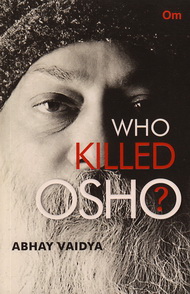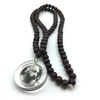New book about Osho with misleading sensational title

Kaiyum reviews the recently published book ‘Who killed Osho?’ by Abhay Vaidya.
Comment by Osho News editing team
We are publishing this review with the clear understanding that the most important work for us is to focus on and disseminate Osho’s efforts to wake up people and to bring about a change in consciousness on this planet. The book shows a journalistic effort to ‘make sense’ out of matters that have nothing to do with Osho’s vision of the New Man and his tremendous impact on humanity which tangibly continues to grow and is, in our view, unstoppable. The old man’s mind with its conditioned settings thrives on problems and appearances using borrowed information from the past. That is the nature of the illusory world – living in old patterns.
“…There is much investment in falsity, in the masks, in the faces, in the games you go on playing. To be initiated as a sannyasin means now you will try to be authentic; whatsoever the consequences, you will accept them and live in the present. You will sacrifice the future for the present; you will never sacrifice the present for the future. This moment will be the totality of your being, you will never move beforehand.
This is what sannyas is – to kick the pot and walk out, and not to wait for the results. Results will take care of themselves, they will follow you.”
Osho, A Bird on the Wing, Ch 5
Related article on Osho News
Stop this sensationalist nonsense
Review
If you like thrillers, crime novels and detective stories and prefer non-fiction, then this recently-published (2017) investigation by independent journalist Abhay Vaidya should interest you.
And it will certainly interest you if you are a sannyasin or lover of Osho who is unhappy about changes that have gradually been carried out at the Poona II ashram since Osho left his body in 1990.
First key theme: suspicions
Vaidya appears to be thorough in his analysis of all available sources and material, as may be expected from an investigative journalist. From biographical notes, it’s clear that Vaidya has respect for and appreciation of Osho.
The book begins with several pages containing the biographies of some 22 key sannyasins, “… close followers who were witness to dramatic development inside Osho Commune International, Pune, on the day he died…”
These are the chief characters in a story that briefly covers much of Osho’s life, with increasing detail up to Nirvano’s (Vivek’s) death “in suspicious circumstances… barely 41 days before Osho’s death.”
That Nirvano was “in a romantic relationship with Jayesh at the time of her death” is the start of an increasing amount of evidence showing that key people are involved in a clear, well-established plan to exclude all ‘old’ sannyasins, remove the association of Osho as a spiritual master from the trademark ‘Osho’, concentrate on marketing Osho brand meditation methods and materials, take steps to ensure a declining number of visitors and finally – but this remains conjecture – prepare for the sale of the fabulously valuable Koregaon Park properties as prime real estate.
Second key theme: copyright
A number of names keeps cropping up in relation to the many foundations, trusts and other legal entities in countries such as the USA, Switzerland, Ireland and to a minor extent in India. The one organisation that is centre-stage is the Osho International Foundation (OIF). To quote from the book:
… some very striking revelations – of doubtful authenticity – were made by Jayesh in his Witness Statement on July 19, 2011 before the EUIPO (red.: European Union Intellectual Property Office). Jayesh testified that while leaving the U.S. in November 1985, Osho instructed him that his intellectual property rights; (sic) copyrights to his work, “to his name and image” be transferred from a U.S. foundation to the Swiss Foundation, known today as Osho International Foundation.
There are pages and pages of testimony, explanations and conflicting statements – conflicting especially with Osho’s constant clarity on this subject, such as these words:
“You don’t understand what meditation is. It is nobody’s belonging, possession. You cannot have any copyright. Perhaps if your country gives you trademarks and copyrights on things like meditation, then it will be good to have a copyright on stupidity. That will help the whole world to be relieved… Only you will be stupid and nobody else can be stupid; it will be illegal.” (1)
Vaidya is thorough in his investigations into the shenanigans around ‘control’ of the business empire that Osho’s legacy constitutes, yet leaves the reader plenty of space to draw his own conclusions.
Third key theme: Osho’s will
On 4 June 2013 a so-called ‘true copy of Osho’s Will dated 15th October, 1989’ was produced by OIF – 23 years after Osho left his body. A new character comes on the scene: Philip Toelkes (Prem Niren) was Osho’s Personal Attorney from 1982 to 1990 and later worked for OIF. In 1990…
… Amrito, who officially represented the Commune, was categorical that Osho did not leave behind any Will. He and the Commune’s spokesperson, Chaitanya Keerti denied the existence of Osho’s Will when specifically asked by the press. There was no mention of any Will by Osho in the 23 years that intervened, till it was produced in Spain.
Osho was very clear about not leaving a will:
“I love my people so much that I cannot create any hindrance in their life in the future. I cannot give them any instructions.” (2)
The author relates in significant detail how the will was proven to be a forgery and was ultimately withdrawn from the legal proceedings. Apparently, no further action was taken against the forgers, but the evidence implying manipulation of facts to gain control over funds continues to build up.
Fourth key theme: the doctor
The Indian ENT specialist Dr. Gokul Gokani (Anand Krishna) enters the arena of suspicion as he is formally requested (by Jayesh and Amrito) to sign Osho’s death certificate. Vaidya raises various pertinent questions about the actual time of death and the motives behind involving Gokani.
Differences of opinion
Very clear in Vaidya’s text is that he rather discounts the standard line of thallium poisoning along with possible exposure to a source of radiation. He ignores mentioning that Osho refers on several occasions to this serious intervention in his health:
“… I am absolutely certain that I was poisoned in Oklahoma with a certain metallic poison, thallium, but it has not been able to kill me.” (3)
“… I have an inner, intuitive guarantee that in the Oklahoma jail I was poisoned, poisoned with thallium, which has shown its effects over the last two years. It remains deposited in the body and becomes active over a period of time. But it has to be given in small doses; if you give it in a big dose, then the effects will be immediate. This was the reason why the bail was refused and I was dragged for twelve days from one jail to another jail.” (4)
“… they dragged me from jail to jail; in twelve days I was dragged to six jails.
Only later on I became aware of it, when the British experts in poisoning looked into my symptoms and gave the verdict, that I was given a certain poison, thallium. It is not detectable either from blood or from urine; it simply disappears. I had all the symptoms – when the poison disappears, it leaves certain kinds of sicknesses in the body. This poison has been used against political prisoners. But if you give it in a bigger dose, the person dies immediately. That’s why they wanted twelve days, to give it to me in small doses so I would not die in their jails – they would be condemned by the whole world.” (5)
International or primarily India?
Although Vaidya has broad international experience and is associated with various journalistic institutes in the West, there is evidence that – unless it’s just a question of inattentive editing – the book is targeted at the Indian, English-speaking market, or perhaps the world of sannyasins familiar with India. He writes, for example, about a “…property with an estimated value of Rs. 8 crore…” and terms like ‘Commune In-charge’ – that sannyasins, familiar with the Commune will recognise, but that sound very strange to refer to a superintendent of some level and responsibility. Sentences that include incorrect English (perhaps acceptable Indian English!) abound, like “He decided not to avail of the free food pass…” and “Till Osho was alive, Keerti had complete freedom…”
Writing style
The narrative flows with a certain ease and a pace that maintain the interest. At the same time, frequent illogically and incorrectly placed commas disturb the flow. Equally irritating is the inconsistent mixture of American-style and British-style punctuation, particularly with inverted commas. A sign of poor editing and a lack of professional proofreading is the large number of places where Vaidya repeats himself, explaining points for a second and even a third time. Combine this with the myriad spelling errors and the conclusion is clear: this book would greatly benefit from a round of thorough editing and rigorous proofreading.
All in all…
… the book captures the essential history of the world of Osho and provides an account (considering the data currently available) of the circumstances leading to the deaths of Osho and Nirvano (described as ‘his soulmate’, a term Osho never used for her), and Vaidya writes in detail about potentially nefarious business activities of the last 30 years or so. There is a clear appeal to investigate the affairs of the Osho trusts as they exist today.
Review by Kaiyum
About the author
DNA India
Quotes by Osho from
(1) Om Shanti Shanti Shanti, Ch 26, Q 1
(2) The Last Testament Vol 2, Ch 14 (excerpt)
(3) Om Mani Padme Hum, Ch 12, Q 1
(4) Communism and Zen Fire, Zen Wind, Ch 1, Q 2
(5) Hari Om Tat Sat, Ch 8, Q 1
Related article on Osho News
From Bhagwan to Osho
Available at
OshoViha – amazon.com – amazon.co.uk – amazon.de – amazon.in
- Log in to post comments
- 37 views
